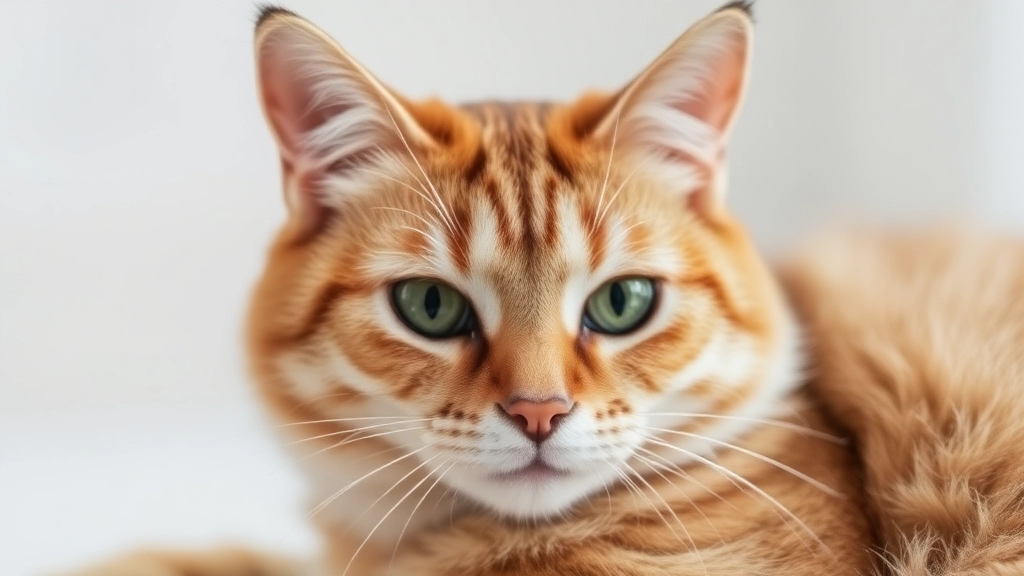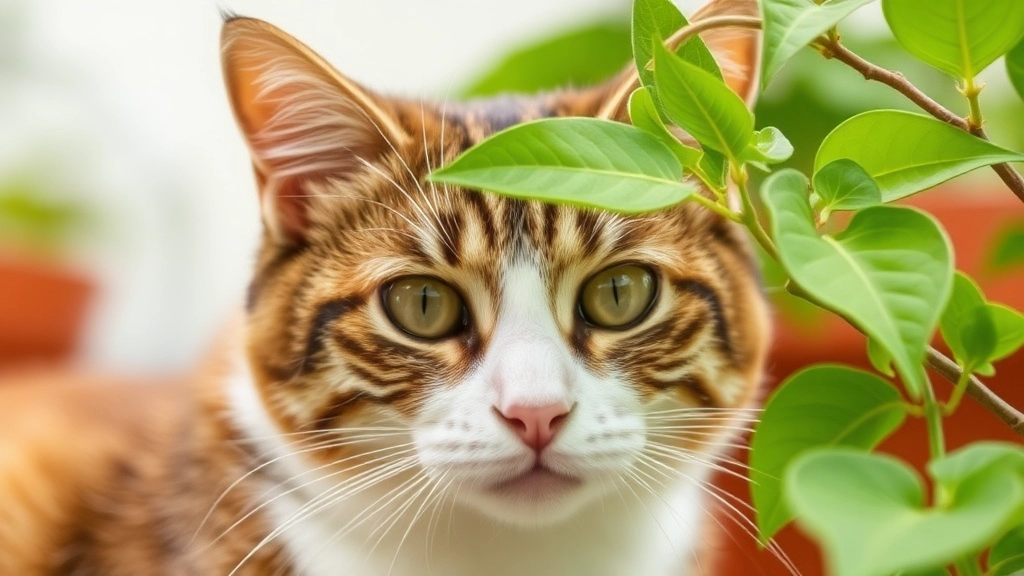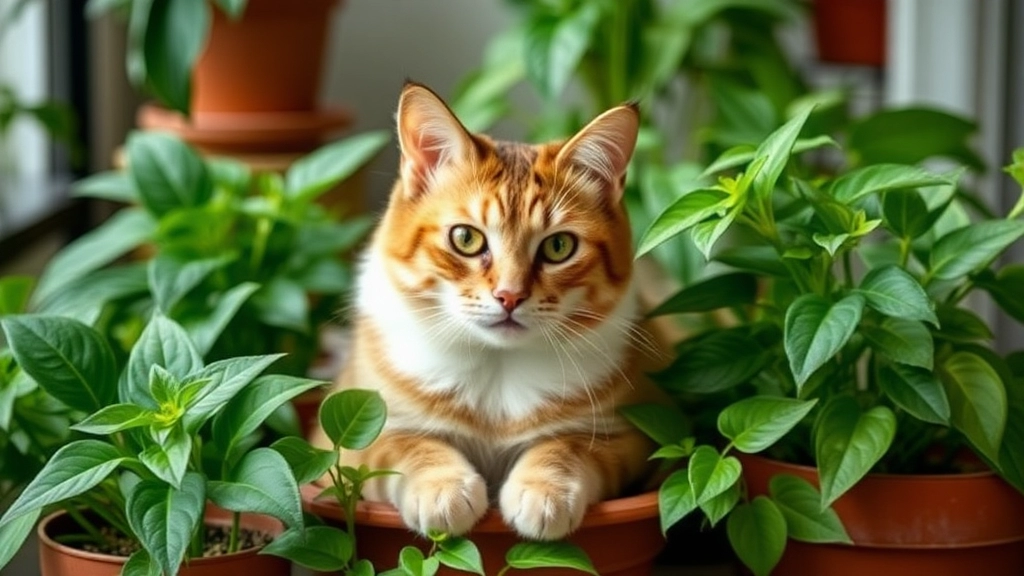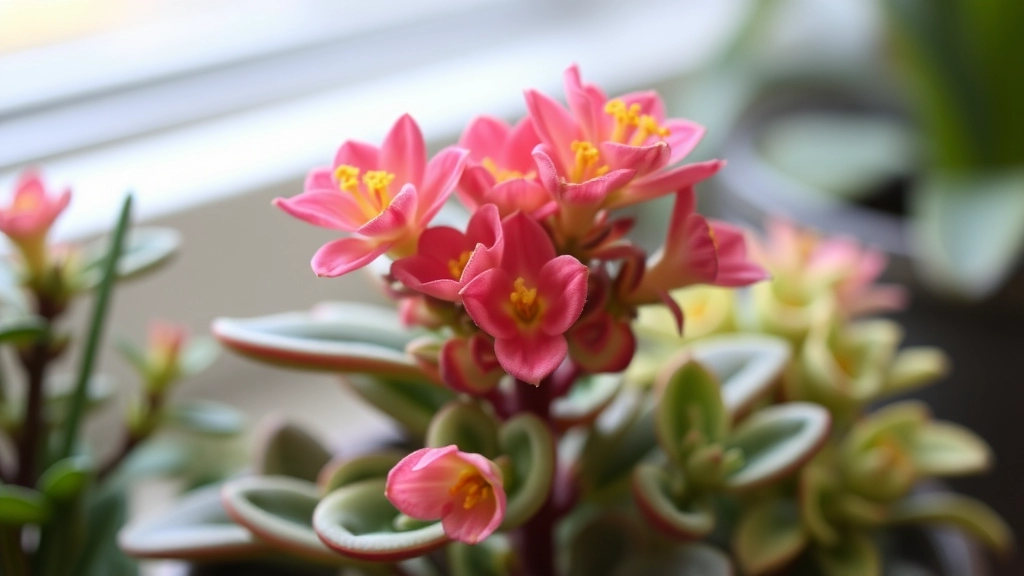Understanding Kalanchoe and Its Risks to Cats
As a florist, it’s crucial to know which plants can be harmful to our furry friends. One such plant is the Kalanchoe. Florist Kalanchoe toxic to cats is a common concern among pet owners, and understanding the risks can help us provide better advice to our customers.
In this article, we’ll explore why Kalanchoe is dangerous for cats, the symptoms of poisoning, and what to do if your cat ingests this plant. Stay informed and keep your pets safe by learning more about this beautiful yet potentially harmful plant.
Identifying Kalanchoe Plants
Are you worried that your cat might accidentally munch on a plant that could harm them? Understanding how to identify Kalanchoe plants is essential for any cat owner.
Kalanchoe, a popular succulent, is known for its vibrant flowers and fleshy leaves. However, it is also toxic to cats, making identification crucial for their safety. Here are some key features to help you spot a Kalanchoe:
- Leaf Structure: Kalanchoe leaves are thick, fleshy, and often have a slightly waxy texture. They can be smooth or have serrated edges.
- Flower Appearance: The flowers are typically small and bell-shaped, often appearing in clusters. They can be red, pink, yellow, or white, adding a splash of colour to your home.
- Plant Size: Kalanchoe plants can vary in size but generally grow between 30 cm to 90 cm tall, depending on the species.
- Stem Characteristics: The stems are sturdy and may have a reddish tint. They can also be somewhat woody as the plant matures.
By being able to identify Kalanchoe plants, you can take proactive steps to keep your feline friend safe. For more information on the toxicity of Kalanchoe to cats and other essential safety tips, make sure to read our detailed guide. Additionally, if you’re interested in learning about the health benefits and practical uses of Kalanchoe leaves, we’ve got you covered.
Symptoms of Kalanchoe Toxicity in Cats

So, you suspect your furry friend might have nibbled on a Kalanchoe plant?
It’s crucial to know the signs of toxicity. Cats are curious creatures, and sometimes their curiosity can lead to trouble. Kalanchoe plants contain compounds that can cause some serious health issues for our feline pals.
Common Symptoms to Watch For:
- Vomiting: One of the first signs that something’s not right.
- Diarrhoea: If your cat’s tummy is upset, this could be a red flag.
- Lethargy: If your usually playful kitty is suddenly a couch potato, keep an eye on them.
- Loss of Appetite: Not interested in dinner? That’s unusual.
- Abdominal Pain: Look for signs like hiding or excessive grooming.
- Rapid Heart Rate: If your cat seems a bit too energetic or anxious, it might be worth checking.
If your cat shows any of these symptoms after munching on Kalanchoe, it’s time to take action.
If you suspect that your cat has ingested Kalanchoe, it’s natural to feel a surge of panic. Understanding the immediate steps you can take will help you respond effectively and ensure your furry friend receives the care they need.
– **Assess the Situation:**
– Determine how much of the plant your cat has eaten.
– Check for any visible symptoms, such as vomiting, lethargy, or changes in behaviour.
– **Keep Calm:**
– Cats can sense your anxiety. Staying calm will help you think clearly and act decisively.
– **Remove Access:**
– Ensure your cat cannot access any more Kalanchoe or other toxic plants.
– **Contact Your Veterinarian:**
– Call your vet immediately. Provide details about the plant and the amount ingested.
– Follow their instructions carefully. They may recommend bringing your cat in for examination.
– **Monitor Symptoms:**
– Keep a close eye on your cat for any signs of distress or worsening symptoms.
– Document any changes to share with your vet.
– **Do Not Induce Vomiting Without Guidance:**
– Inducing vomiting can sometimes do more harm than good. Always consult your vet before taking this step.
For more information on the care and propagation of Kalanchoe plants, you can check out our [Kalanchoe Mother of Thousands Care and Propagation Guide](https://planthq.org/kalanchoe-mother-of-thousands-care-propagation-and-flowering/) and [Kalanchoe Delagoensis Care](https://planthq.org/kalanchoe-delagoensis-care-mastering-mother-of-millions/).
Long-term Health Effects on Cats

When it comes to Kalanchoe toxicity, many cat owners worry about the potential long-term effects on their feline friends.
What Could Happen?
If a cat ingests Kalanchoe, the immediate symptoms can be alarming, but what about the future? Here are some potential long-term health effects to consider:
- Kidney Damage: Prolonged exposure or ingestion can lead to kidney issues, which may not show symptoms until they become severe.
- Gastrointestinal Problems: Persistent digestive issues, such as vomiting or diarrhea, may arise even after the initial toxicity has passed.
- Neurological Effects: In rare cases, neurological symptoms could develop, affecting coordination or causing seizures.
- Chronic Health Conditions: Cats may develop chronic conditions that require ongoing veterinary care, leading to increased stress for both pet and owner.
Monitoring Your Cat’s Health
If you suspect your cat has ingested Kalanchoe, it’s crucial to monitor their health closely.
- Regular Vet Check-ups: Schedule follow-up appointments to ensure no long-term damage has occurred.
- Watch for Symptoms: Keep an eye out for any unusual behaviour or health changes, such as lethargy or changes in appetite.
Safe Alternatives to Kalanchoe for Cat Owners
As we explore safer options for our feline friends, it’s essential to understand that not all plants are created equal. Many houseplants can pose risks to our pets, and Kalanchoe is one of them. Fortunately, there are plenty of beautiful, non-toxic alternatives that can brighten your home without endangering your cat’s health.
Non-Toxic Plant Options
Here are some safe and attractive plants to consider:
- Spider Plant (Chlorophytum comosum):
- Hardy and easy to care for.
- Cats often enjoy playing with its arching leaves.
- Boston Fern (Nephrolepis exaltata):
- Adds a lush, green touch to any room.
- Prefers humidity, making it perfect for bathrooms.
- Areca Palm (Dypsis lutescens):
- Elegant and tall, great for corners.
- Safe for cats and adds a tropical vibe.
- Bamboo Palm (Chamaedorea seifrizii):
- Low maintenance and purifies air.
- Cats can safely explore its fronds.
- Calathea (Calathea spp.):
- Known for its stunning leaf patterns.
- Non-toxic and brings a pop of colour indoors.
Tips for Choosing Cat-Safe Plants
When selecting plants, consider the following:
- Research: Always double-check if a plant is safe for cats.
- Purchase from Reputable Sources: Ensure that the seller provides accurate information about plant toxicity.
- Observe Your Cat: Some cats may be more curious than others. Monitor their interactions with new plants.
By opting for these safe alternatives, you can create a vibrant indoor garden that keeps both your home and your cat safe. For more information on why Kalanchoe might be harmful to your pets, check out our article on Kalanchoe Toxic to Cats: Essential Safety Information. If you’re still interested in Kalanchoe and need tips on how to safely grow them, our How to Care for a Kalanchoe Succulent: Expert Tips guide can be a helpful resource.
Preventing Plant Poisoning in Cats

Worried about your cat munching on something they shouldn’t? You’re not alone! Many cat owners share the same concern, especially when it comes to toxic plants like Kalanchoe.
Here are some straightforward strategies to keep your furry friend safe:
- Choose Cat-Friendly Plants: Opt for plants that are non-toxic to cats. Some great options include spider plants, cat grass, and Boston ferns.
- Create a Plant Barrier: If you love having plants around, consider placing them in high spots or using hanging planters. This keeps them out of reach from curious paws.
- Educate Yourself: Familiarise yourself with common toxic plants. Knowing what to avoid can make a huge difference.
- Use Deterrents: Cats often dislike certain scents. Spraying citrus or using bitter-tasting sprays on your plants can deter them from nibbling.
- Regular Checks: Keep an eye on your plants and your cat. If you notice any signs of nibbling, take action immediately.
- Provide Alternatives: Set up a designated area with safe plants or cat grass for your kitty to enjoy. This gives them a safe outlet for their natural curiosity.
By taking these steps, you can create a safer environment for your cat and enjoy your plants without worry.
If you suspect your cat has ingested Kalanchoe, the first thought might be, “What should I do next?”
It’s crucial to consult a veterinarian promptly.
### Why Consult a Veterinarian?
– **Expert Diagnosis**: Only a vet can accurately assess the situation and determine the level of toxicity.
– **Tailored Treatment**: Your cat may require specific treatments based on their size, age, and health status.
– **Peace of Mind**: Knowing you’ve sought professional help can alleviate your worries.
### When to Contact a Vet?
– If your cat shows any symptoms of [Kalanchoe toxicity](https://planthq.org/kalanchoe-toxic-to-cats-essential-safety-information/).
– If you are unsure about the amount ingested.
– If your cat has pre-existing health conditions.
### What to Expect During the Consultation
– **History Taking**: Be ready to provide details about your cat’s behaviour and any symptoms observed.
– **Physical Examination**: The vet may perform a thorough examination to assess your cat’s condition.
– **Treatment Options**: Depending on the severity, treatment may include inducing vomiting or administering activated charcoal.
In situations like this, every minute counts.
Always keep the contact details of your vet handy, and consider having an emergency vet clinic in mind as well. For more information on Kalanchoe care, you can refer to this [guide on essential care tips and tricks](https://planthq.org/how-to-grow-kalanchoe-essential-care-tips-and-tricks/).
Common Toxic Houseplants for Cats

So, you’ve discovered that Kalanchoe is a no-go for your feline friend. But what about other plants lurking in your home? It’s crucial to know which ones can be harmful.
Here’s a quick rundown of some common toxic houseplants for cats:
- Lilies: Beautiful but deadly. They can cause kidney failure in cats, even with just a small nibble.
- Pothos: This popular plant can lead to oral irritation and vomiting. Not the best choice for a cat-friendly home.
- Philodendron: Another common houseplant that can cause swelling and pain in the mouth and throat.
- Sago Palm: Highly toxic, this can lead to severe liver damage and even death if ingested.
- Aloe Vera: While great for humans, it can cause vomiting and diarrhea in cats.
- Peace Lily: Not a true lily, but still toxic. It can irritate the mouth and throat, leading to difficulty swallowing.
- Dieffenbachia: Also known as dumb cane, it can cause intense burning and swelling of the mouth and throat.
Knowing these plants can save you a lot of worry. If you’re ever uncertain about a plant, it’s best to err on the side of caution.
Creating a Cat-Safe Garden
As we consider the importance of keeping our feline friends safe from toxic plants, creating a cat-safe garden becomes essential.
Why is a Cat-Safe Garden Important?
Cats are naturally curious creatures, often exploring their surroundings by nibbling on plants. This curiosity can lead to accidental ingestion of harmful species.
Tips for Designing a Cat-Safe Garden:
- Choose Non-Toxic Plants:
- Opt for cat-friendly plants like catnip, cat grass, and spider plants.
- Avoid common toxic plants such as Kalanchoe, lilies, and azaleas. For more information on the toxicity of Kalanchoe, refer to essential safety information.
- Create Barriers:
- Use fencing or raised beds to keep cats out of certain areas.
- Consider using decorative stones or mulch to deter digging.
- Designate a Cat Area:
- Set aside a space just for your cat, filled with safe plants and toys.
- Incorporate scratching posts and climbing structures to keep them entertained.
- Regular Maintenance:
- Keep your garden tidy by removing any dead or decaying plants that might attract cats.
- Regularly check for any new plants that may have been introduced to your garden.
- Educate Yourself:
- Familiarise yourself with both safe and toxic plants.
- Consult resources or guides specifically for cat owners. For a comprehensive guide on Kalanchoe care, check out this Kalanchoe plant care guide.
By taking these steps, you can create a beautiful outdoor space that is safe for your furry companions.
Resources for Pet Owners and Toxic Plants
So, you’ve discovered Kalanchoe is toxic to cats, and now you’re wondering what to do next. You’re not alone in this concern. Many pet owners face the challenge of keeping their furry friends safe from harmful plants.
Online Databases
- ASPCA’s Plant Database: This is a go-to for checking if a plant is safe for your pets. Just type in the plant name, and you’ll get all the info you need.
- Pet Poison Helpline: They offer a quick lookup for toxic plants and even have a hotline for emergencies.
Books
- “The Complete Guide to Cat Care”: This book includes sections on safe plants and how to create a cat-friendly environment.
- “Toxic Plants for Pets”: A handy guide that lists common toxic plants, including Kalanchoe, along with symptoms to watch for.
Mobile Apps
- PlantSnap: Snap a photo of a plant, and it’ll tell you whether it’s safe for your pet. Super handy for those spontaneous plant purchases!
- Pet First Aid: This app provides emergency tips and a list of toxic plants, ensuring you’re prepared in case of an accidental ingestion.
Community Resources
- Local Vet Clinics: Many vet clinics have pamphlets or resources on toxic plants. Don’t hesitate to ask!
- Online Forums: Join pet owner groups on platforms like Facebook or Reddit. Sharing experiences and tips can be invaluable.
Additional Reading
- For more information on how to care for your Kalanchoe plants, check out our Complete Care Guide for Kalanchoe Blossfeldiana.
- Learn about the different Types of Kalanchoe Varieties and how to care for each one.
FAQs on Kalanchoe Toxicity in Cats
What are the symptoms of Kalanchoe toxicity in cats?
If your cat has ingested Kalanchoe, you may notice symptoms such as vomiting, diarrhea, lethargy, loss of appetite, abdominal pain, and a rapid heart rate. It’s crucial to seek veterinary care if you observe any of these signs.
Can Kalanchoe toxicity cause long-term health effects in cats?
Yes, prolonged exposure or ingestion of Kalanchoe can lead to serious long-term health issues like kidney damage, gastrointestinal problems, neurological effects, and chronic health conditions that may require ongoing veterinary care.
How can I prevent my cat from eating toxic plants like Kalanchoe?
To prevent plant poisoning, you can choose cat-friendly plants, create a plant barrier, educate yourself about toxic plants, use deterrents, perform regular checks, and provide safe alternatives like cat grass.
What should I do if I suspect my cat has ingested Kalanchoe?
If you suspect your cat has ingested Kalanchoe, it’s important to monitor their health closely and seek veterinary care immediately. Regular vet check-ups and vigilance for any unusual symptoms are crucial.
Are there other common houseplants that are toxic to cats?
Yes, several common houseplants are toxic to cats, including lilies, pothos, philodendron, sago palm, aloe vera, peace lily, and dieffenbachia. It’s best to avoid these plants in a cat-friendly home.
How can I create a safe environment for my cat while keeping houseplants?
To create a safe environment, opt for non-toxic plants, use plant barriers, and provide safe alternatives. Regularly check your plants and cat for any signs of nibbling or distress.
What are some signs that my cat might be experiencing abdominal pain from plant toxicity?
Signs of abdominal pain in cats include hiding, excessive grooming, and general discomfort. If you notice these behaviors, it’s important to seek veterinary advice.
Can the use of deterrents help in preventing my cat from eating toxic plants?
Yes, using deterrents like citrus sprays or bitter-tasting sprays can help prevent your cat from nibbling on toxic plants. Cats often dislike certain scents, which can act as a natural deterrent.
References
-
ASPCA – Kalanchoe
-
Pet Poison Helpline – Kalanchoe
-
Cornell Feline Health Center – Kalanchoe Poisoning in Cats
